EMA examines how enterprises are preparing their networks to support artificial intelligence (AI) investments.
Add blog content here…
Add blog content here…
San Diego, Calif., June 5, 2025 (GLOBE NEWSWIRE) — BlueCat Networks, a leading provider of Intelligent Network Operations solutions that help organizations modernize, optimize, and secure their network infrastructure, is proud to be the first vendor to market with a suite of products aimed at making networks more agile so that companies can focus on innovation. At Cisco Live, BlueCat will unveil the next generation of its Unified DDI platform, Integrity X, as well as other exciting updates to its industry-leading product set. Additionally, BlueCat will introduce a new certified Cisco Splunk application for its network observability and intelligence solutions, LiveWire and LiveNX.
Accelerate network transformation
Organizations need networks that change fast. However, increased complexity and legacy solutions create unnecessary drag. When the network is slow to deliver, organizations struggle to create memorable customer experiences, proactively detect and mitigate cyber threats, and harness the benefits of cloud and artificial intelligence.
Intelligent NetOps is an integrated portfolio of network infrastructure services. It discovers and enables network access, automates provisioning and workflows, captures and analyzes operational data, and continuously optimizes and secures the network across hybrid and multicloud environments.
“A key challenge faced by networking teams is to efficiently and effectively manage disparate infrastructure across multiple environments while ensuring high levels of security and user experience,” said Brandon Butler, IDC Senior Research Manager for Enterprise Networks. “BlueCat’s DDI management and network observability solutions help teams overcome these challenges by providing intelligent visibility and analytics, which can be correlated with changes occurring across the network and on individual devices, enabling teams to maintain reliability and accelerate transformation initiatives.”
BlueCat launches Integrity X: The future of enterprise DDI
Integrity X redefines how enterprise network teams automate and manage core DNS, DHCP, and IP address management (DDI) infrastructure. Built on a modern React framework and with an API-first design that leverages the same OpenAPI interface customers already use for automation, this release introduces a fully reimagined user experience—engineered to streamline workflows, strengthen security posture, and accelerate innovation across hybrid environments.
“These enhancements are exactly what enterprise teams need,” said a senior developer of system design and architecture engineering at a large health care data provider. “BlueCat is listening, solving real-world DDI challenges, and enabling agile network infrastructure.”
A next-generation DDI platform for modern networks
Integrity X delivers unmatched scalability, performance, accessibility, and extensibility—bringing together everything network teams need in a single, unified DDI solution:
- Unified by design: A cohesive platform experience that feels fast, seamless, and intuitive—tailored to the needs of today’s dynamic enterprise environments.
- API-first innovation: Built on a fully RESTful API that is OpenAPI 3.0 compliant, enabling rapid feature delivery, seamless integration, and long-term extensibility for automation-driven organizations.
- Accessibility for all: WCAG 2.1 AA-compliant by design, with high-contrast visuals, full keyboard navigation, and screen reader support—ensuring inclusive access for all users.
- Multi-language support: Global-ready with localization in English, German, French, Spanish, Portuguese, Chinese, and Japanese.
- Real-time visibility: Always-on monitoring and a powerful new appliance metrics dashboard, based on open-source Prometheus, give teams instant insight into DNS, DHCP, and IPAM health—enabling proactive operations and faster troubleshooting.
“Integrity X provides a modern, standards-based path forward for customers who want control,” said Scott Fulton, Chief Product and Technology Officer at BlueCat. “New customers are relieved with the low-risk migration from other solutions, and existing customers have already been impressed with the ease of automation, scalability, and flexibility of the platform.”
BlueCat enriches Splunk integration and DNS and DHCP health analysis
BlueCat now provides NOC and SOC Dashboards to diagnose performance and security issues in your network with an improved certified Splunk application:
- LiveWire captures, analyzes, and simultaneously streams enriched security and performance telemetry from your network to Splunk and LiveNX.
- LiveNX continuously analyzes enriched telemetry, SNMP, and API data for security indicators and network anomalies and sends alerts to Splunk to help in threat hunting and resolving anomalies.
- LiveNX alerting engine sends security indicators and network anomalies to Splunk, aiding in threat hunting or resolving anomalies.
- BlueCat’s Splunk crosslink capabilities enable quick packet or flow diagnostic research all from within Splunk.
LiveWire and LiveNX 25.1 releases include additional instrumentation for DNS and DHCP, as well as automated troubleshooting for routine runtime, performance, and security issues surrounding these mission-critical services.
Micetro is now available on Cisco’s Global Price List (GPL)
BlueCat also announced that Micetro, an intuitive universal DDI orchestration solution, is available on the Cisco GPL. Micetro seamlessly integrates with Meraki, delivering improved IPAM visibility and DHCP orchestration. Expanded availability streamlines procurement for customers and partners. It showcases BlueCat and Cisco’s commitment to enhancing network operations with integrated solutions.
-30-
About BlueCat
BlueCat’s Intelligent Network Operations (NetOps) provide the analytics and intelligence needed to enable, optimize, and secure the network to achieve business goals. With an Intelligent NetOps suite, organizations can more easily change and modernize their network as business requirements demand. BlueCat’s growing portfolio includes unified core network services, security and compliance, as well as network observability and intelligence. These solutions can be deployed in hybrid or multicloud environments, in the data center, at remote or branch locations, and via SD-WAN. BlueCat’s Intelligent NetOps solutions have been recognized by GigaOm as market leaders in their 2025 Radar Report for Network Observability and their 2024 Radar Report for DDI. BlueCat is headquartered in Toronto and New York, with additional offices in the United States, France, Germany, Iceland, Japan, Singapore, Serbia, and the United Kingdom. Learn more at bluecat.com.
—
Contact:
Pierre Hamilton
Senior Manager, Corporate Communications
[email protected]
In today’s complex IT landscape, managing DNS across hybrid cloud environments can be challenging. Networks spanning on-premises infrastructure, Microsoft Azure, AWS, and beyond face numerous threats and potential points of failure. To overcome these challenges, enterprises require robust, intelligent DNS solutions capable of ensuring resilience, optimizing performance, and enhancing security.
BlueCat Micetro’s xDNS feature is designed to deliver redundancy, mitigate DNS-based attacks, and simplify management in heterogeneous DNS environments and across multiple clouds.
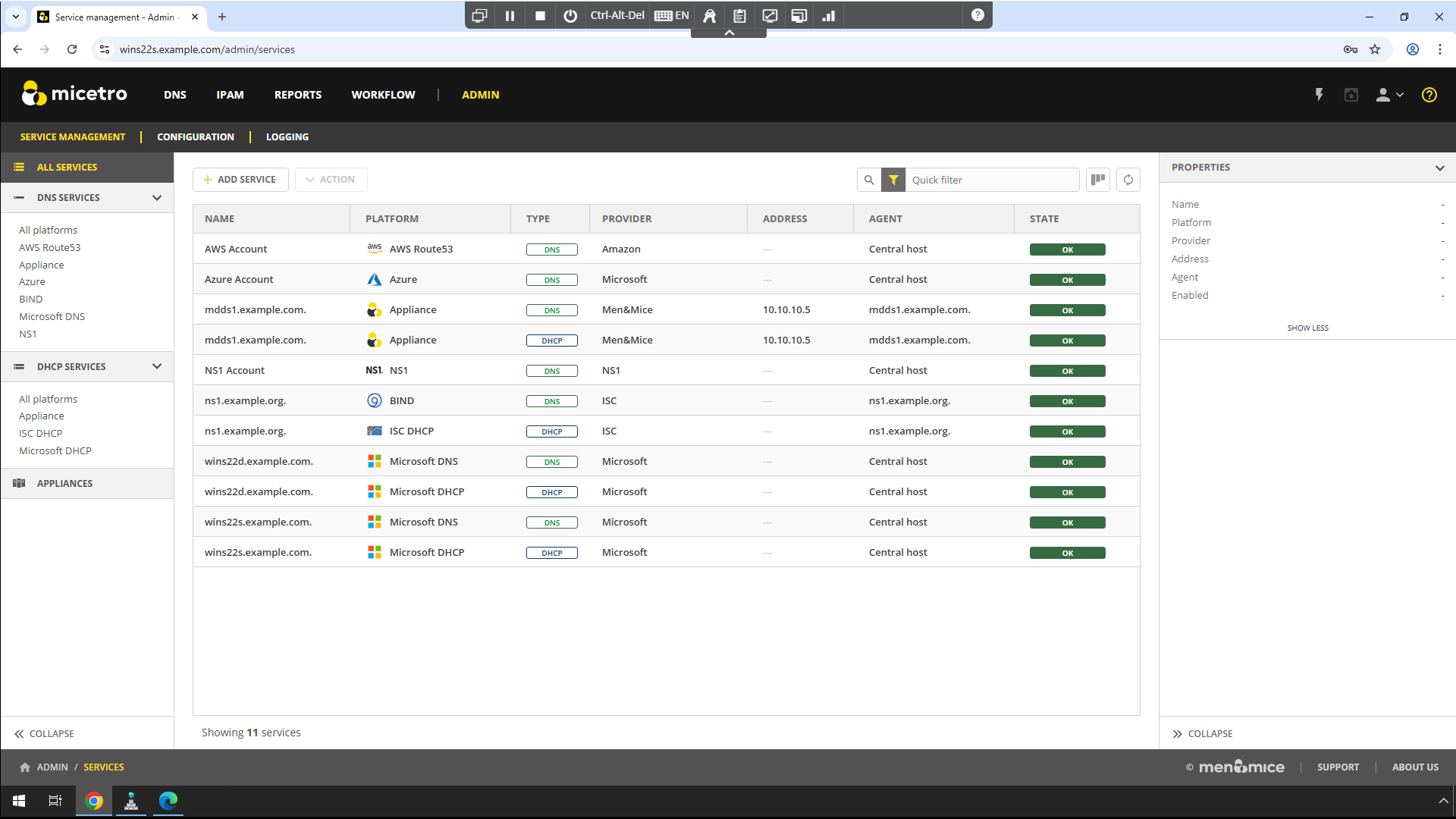
Why traditional DNS falls short
Managing DNS with traditional tools or individual cloud-provider consoles introduces several critical issues:
- Single points of failure: Traditional DNS setups can become single points of failure, risking costly downtime if one server or service provider goes offline.
- Limited attack mitigation: Without redundancy, DNS servers become vulnerable to attacks such as Distributed Denial of Service (DDoS), leading to severe disruptions.
- Lack of hybrid visibility: Enterprises struggle with fragmented DNS management across multiple platforms, lacking cohesive visibility and control.
How xDNS changes the game
In previous posts, we looked at how easy Micetro makes managing on-premises Microsoft DNS/DHCP servers, as well as managing cloud-based DNS and IP spaces in Azure and AWS. Micetro’s xDNS feature takes managing on-prem and cloud-based DDI from simple management and orchestration to bridging these services, transforming enterprise DNS management by offering powerful, intuitive controls to overcome traditional DNS shortfalls.
By unifying management of on-prem and cloud DNS, xDNS enhances IT capabilities in ensuring DNS availability and managing hybrid cloud environments in several ways:
Built-in redundancy and failover
With xDNS, administrators can effortlessly configure DNS redundancy groups across multiple service providers, including BIND, Windows DNS, Azure DNS, Amazon Route 53, NS1, Dyn, and Akamai Fast DNS. Once an xDNS zone redundancy group has been created, xDNS creates identically replicated zone content, resulting in multiple identical primary zones. Additional DNS zones can be added or removed from the xDNS group as required.
Enhanced protection against DNS failure and attacks
Micetro’s xDNS maintains DNS zone records across multiple service providers or DNS servers. xDNS ensures that each server within the xDNS profile maintains appropriately unique NS and SOA records for the zone, while keeping other record types (A, CNAME, MX, etc.) in sync across providers. In the event of an outage or attack, an alternate service provider will continue to authoritatively serve DNS requests.
Centralized visibility and policy-based synchronization
Micetro’s unified platform delivers complete visibility into DNS configurations and records across hybrid cloud environments. Administrators have the flexibility to define granular synchronization policies, determining exactly how DNS updates propagate between on-premises and cloud environments, further reducing complexity and ensuring consistency.
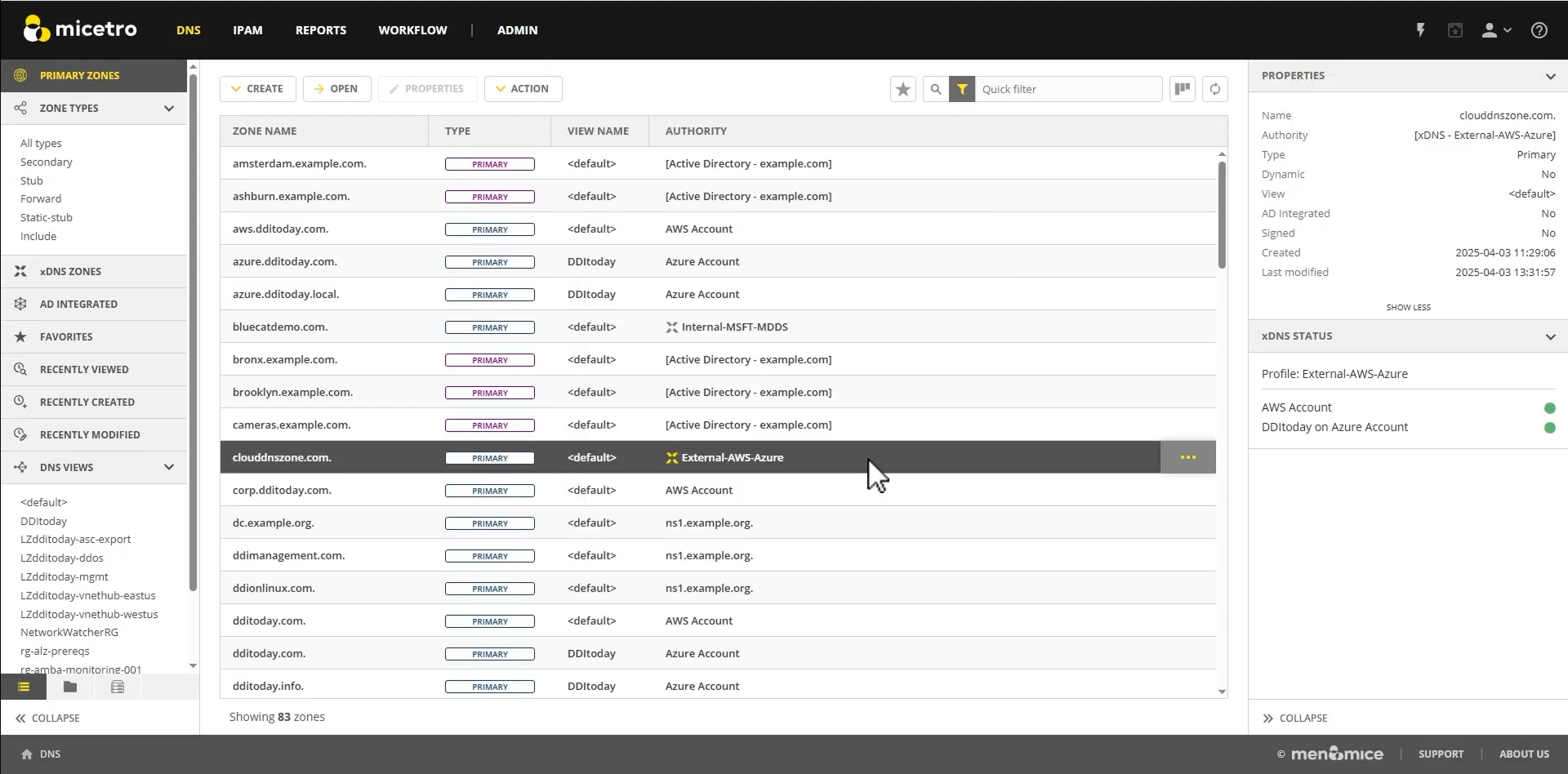
Robust automation and efficiency
Micetro’s comprehensive API support—including REST, SOAP, and JSON-RPC— empowers organizations to automate and customize DNS management workflows. By automating repetitive DNS management tasks, organizations reduce manual overhead, prevent human errors, and significantly enhance operational efficiency. Record adds or changes done through the API are automatically replicated to all members of the xDNS Redundancy Group.
Why choose BlueCat Micetro’s xDNS?
- Reduce downtime and risk: Multiple primary zones across service providers provides automatic failover and proactive attack mitigation ensure constant DNS reliability and security.
- Simplify hybrid DNS management: Centralized interface and powerful automation simplify management, reducing complexity, and enabling scalability.
- Cost efficiency: Prevent costly DNS outages as research shows outages can cost businesses up to 10 times more than maintaining a redundant DNS service.
See xDNS in action
Ready to see xDNS in action? Here’s a quick demo showcasing how Micetro xDNS provides robust DNS redundancy whether on-premises, in hybrid cloud scenarios, or across multiple cloud providers.
Experience the Micetro advantage
Don’t settle for fragmented DNS management solutions. BlueCat Micetro’s xDNS empowers your network teams to build secure, reliable, and redundant internal and external DNS zones.
Ready to simplify and secure your DNS management? Request a free Micetro trial today to see Micetro’s powerful capabilities for yourself.
This is the final of three blog posts exploring nine key reasons to move managing your DNS, DHCP, and IP address management (together known as DDI) from a legacy approach to a unified management solution. The posts in this series are drawn from our white paper, Nine reasons to unify your DDI: Strategic advantages for modernizing your DNS, DHCP, and IP address management.
Technical capabilities play a critical role in supporting innovation, scalability, and security in enterprise IT environments, with DDI forming the backbone of any network.
However, legacy DDI management tools often fall short of meeting modern enterprise network requirements. These limited capabilities can lead to security gaps, create bottlenecks for cloud adoption initiatives, and impede network automation efforts.
It’s tempting for enterprises to get by with the status quo. Why invest in new technology when what you have works well enough? But as the technical debt of legacy tools accrues, the risks to your organization continue to grow.
Moving to a unified DDI platform delivers the technical enhancements necessary for organizations to stay ahead of modern network demands. Here are three compelling technical reasons why unifying your DDI is essential for building a future-proof network:
- Security by design
- Cloud integration
- API programmability
In this post, we’ll explore how each of these technical reasons helps optimize your core network infrastructure. Furthermore, we’ll highlight BlueCat’s solutions for unifying your DDI.

Security by design: Protect your network’s core services
Legacy DDI systems are often riddled with vulnerabilities: fragmented security controls, limited visibility, and reliance on manual processes that create gaps attackers can exploit. With DNS increasingly targeted for attacks, organizations can’t afford to leave their core network services exposed.
Unified DDI transforms security by implementing a comprehensive, built-in approach. Features like centralized policy enforcement, real-time threat detection, and automated response capabilities ensure that your network remains secure against evolving threats. According to Enterprise Management Associates (EMA), enterprises that adopt unified DDI report an 80% faster threat detection rate and significant improvements in incident response times.
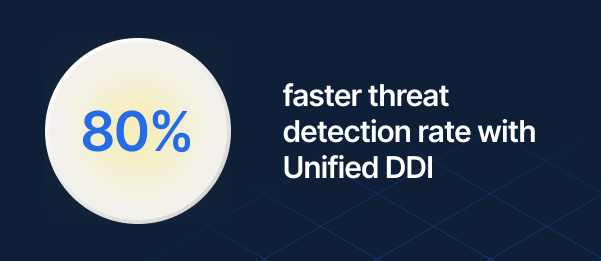
BlueCat’s unified DDI supports advanced DNS security features like DNSSEC to protect against cache poisoning and spoofing attacks. It also offers tools to protect against other common DNS attacks. Furthermore, BlueCat Threat Protection enhances security by dynamically updating blocklists to defend your network from emerging threats.
Additionally, unified DDI supports zero-trust security models through granular access controls and consistent policy enforcement. Role-based access management, based on principles of least privilege, ensures that only authorized users can make changes to your DDI environment. Meanwhile, detailed audit logging tracks every action for analysis and action. This reduces the attack surface and ensures compliance with regulatory standards. By adopting unified DDI, organizations gain the confidence that their network’s foundation is secure, resilient, and ready to withstand modern cyber threats.
Cloud integration: Enable seamless hybrid and multicloud operations
The shift to hybrid and multicloud environments has introduced complexity that legacy DDI systems simply can’t handle. Managing DNS across multiple clouds, maintaining visibility, and ensuring consistent configurations are enormous challenges for IT teams.
Unified DDI simplifies these complexities through integration and automation capabilities built for hybrid and multicloud environments. Automated discovery continuously tracks new cloud resources and synchronizes them with your DDI environment. This provides a single source of truth across your entire cloud landscape. This real-time visibility bridges all cloud platforms. It eliminates manual tracking of DNS zones and records, as well as DHCP scopes and IP spaces.
With BlueCat’s intelligent DNS resolution, unified DDI also optimizes query performance. It dynamically routes requests to the most appropriate resource, whether on premises or in a cloud environment. For organizations managing thousands of daily DNS changes in dynamic cloud environments, this translates to seamless operations without bottlenecks and manual efforts. Advanced features such as automated conflict resolution and policy enforcement ensure consistency and reliability across multiple clouds. This simplifies cloud adoption and migration across clouds.
By adopting unified DDI, enterprises can support advanced cloud architectures with less overhead and cross-cloud visibility. Whether it’s enabling intelligent failover between cloud providers or ensuring compliance through automated policy enforcement, BlueCat unified DDI empowers organizations to accelerate cloud adoption while maintaining control and reliability.
API programmability: Scaling network automation
In the age of DevOps and infrastructure as code, automation is non-negotiable. Yet many legacy DDI systems lack the API capabilities necessary to support modern automation workflows. This leaves IT teams bogged down in manual tasks.
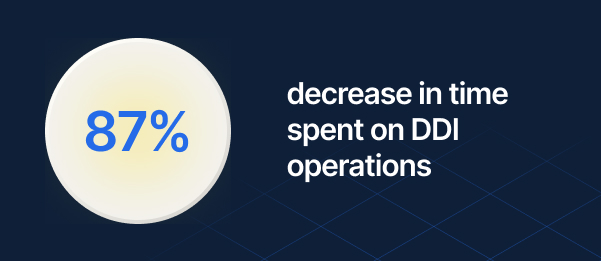
Unified DDI changes the game by providing robust API programmability, enabling seamless integration with existing tools and platforms. With BlueCat’s APIs, organizations can automate critical DDI functions. This includes provisioning new apps and resources, updating configuration changes, integrating with CI/CD pipelines, and enabling self-service provisioning through IT service management systems. This ensures continuous deployment and faster time-to-value for new applications.
For large-scale operations, BlueCat’s APIs support custom integrations with security tools, cloud platforms, and network orchestration systems, enabling end-to-end automation. For example, changes in cloud infrastructure can trigger automated DNS updates, ensuring synchronization without manual intervention. Additionally, adaptive plugins and applications for BlueCat Gateway streamline the development of custom workflows. This allows organizations to tailor their DDI automation to meet their specific business needs.
The results speak for themselves. Enterprises adopting unified DDI report an 86.8% reduction in time spent on DDI operations and accelerated service delivery by 90%. With APIs designed for flexibility and scalability, unified DDI makes your network change-ready. The result is sophisticated automation and integration scenarios that evolve with your business needs.
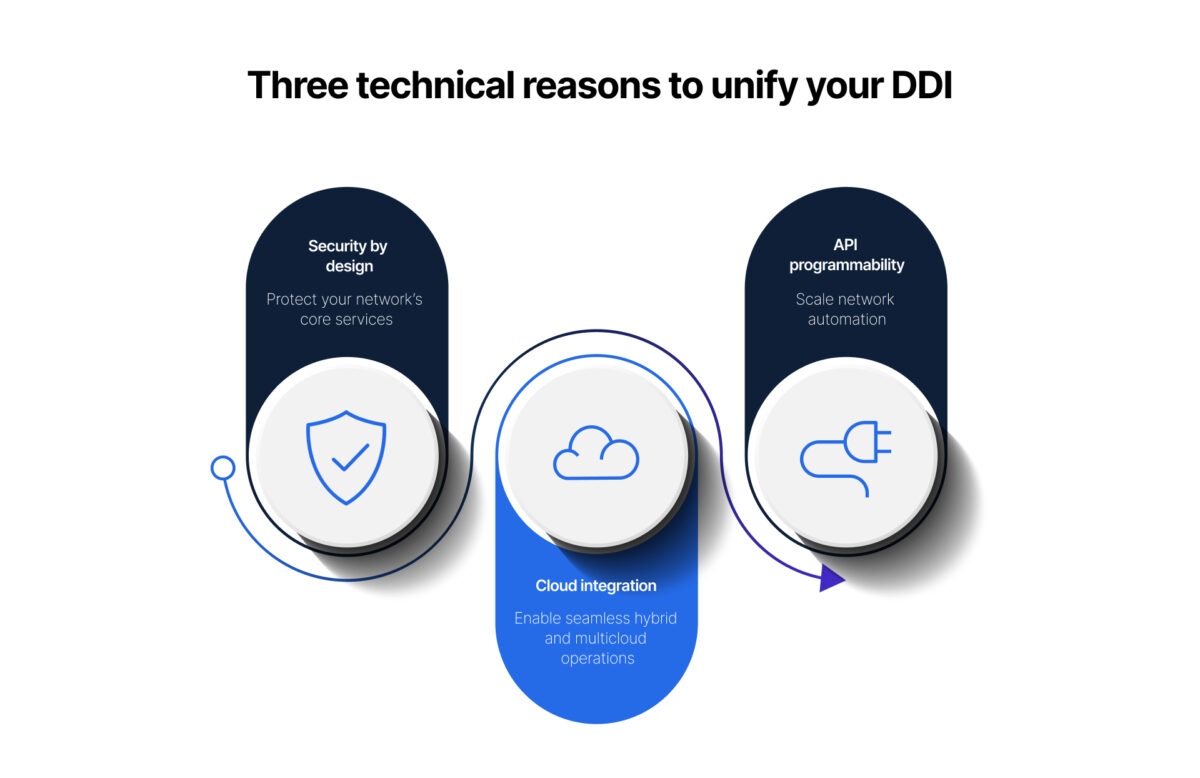
Get Integrity or Micetro for Unified DDI
Unified DDI is more than a modernization effort; it’s a technical evolution that ensures your network is change-ready to meet the today’s and tomorrow’s demands. The technical advantages of unified DDI are clear, from bolstering security and integrating with cloud environments to enabling network automation at scale.
BlueCat Micetro provides a non-disruptive path to Unified DDI. It orchestrates your existing DNS, DHCP, and IP address management infrastructure through a centralized management overlay. Organizations can benefit immediately while maintaining their current DDI investments. Meanwhile, BlueCat Integrity delivers a comprehensive, enterprise-grade DDI platform. It offers complete control over your DDI infrastructure with built-in automation, security, and cloud integration capabilities.
For enterprises looking to build a network that supports innovation, agility, and resilience, unifying your DDI isn’t just an option—it’s a necessity. And an approach that can transform your technical foundation.
Contact us today to learn how Integrity or Micetro can help unify your DDI.
Did you miss the first two blog posts in the series? Read up on the three business-focused reasons and the three operational reasons to optimize your network with Unified DDI.
Welcome to the era of network intelligence.
Combining the authoritative DDI foundation of BlueCat Integrity with LiveAction’s market-leading Network Performance Monitoring (NPM) solutions, LiveNX and LiveWire, empowers organizations to shift from reactive management to proactive, intelligent network operations—fully aligned with modernization initiatives, cloud migration, and security enhancements.
The problem: Lack of full network visibility
Without full visibility into traffic flows, application performance, and packet-level activity, network blind spots can threaten uptime, user satisfaction, and security.
Modern enterprise networks are growing more complex, fragmented, and difficult to secure. While BlueCat Integrity provides a rock-solid foundation for DNS, DHCP, and IP address management (together known as DDI), many organizations still struggle with real-time performance monitoring, deep packet visibility, and rapid troubleshooting across hybrid, cloud, and on-premises environments. Today’s network operations teams need more than control—they need dynamic observability to proactively detect issues, accelerate resolution, and optimize end-user experience.
A combined solution: BlueCat Integrity and LiveAction Network Performance Monitoring
By integrating BlueCat Integrity’s authoritative DDI foundation with LiveAction’s market-leading Network Performance Monitoring (NPM) solutions, LiveNX and LiveWire, organizations can achieve:
- End-to-end network visibility from the infrastructure layer (DNS, DHCP, and IP address) to application and user experience
- Unified troubleshooting that combines authoritative network data with real-time traffic and packet analysis
- Proactive performance assurance by identifying and resolving issues before they impact operations
Key combined solution benefits
- Full stack visibility: Map and monitor network performance from the core (DDI management) to the edge (packet and flow-level traffic), eliminating blind spots across hybrid and multicloud environments.
- Accelerated troubleshooting: Combine DNS and IP data with dynamic traffic analysis to rapidly identify, diagnose, and fix issues—reducing mean time to resolution (MTTR) and improving service levels.
- Optimized performance and security: Correlate DDI events with flow and packet data to detect anomalies faster, prevent misconfigurations, and enhance resilience against outages and attacks.
- Operational efficiency: Enable NetOps and SecOps teams to collaborate better by offering a unified, correlated view of infrastructure, traffic, and user behavior—dramatically reducing tool sprawl and complexity.
- Change-ready network modernization: Support digital transformation, hybrid work, and cloud-first strategies with scalable, intelligent network operations capabilities.
Key features
BlueCat Integrity:
- Centralized DNS, DHCP, and IP address management with policy-driven governance
- Role-based access control, compliance auditing, and automated change tracking
- API-first architecture to integrate across network and security ecosystems
LiveNX (NPM):
- Real-time and historical flow visualization (NetFlow, sFlow, IPFIX, etc.)
- End-to-end application-aware path monitoring across hybrid networks and SD-WAN
- Anomaly detection and predictive performance insights powered by AI and machine learning
LiveWire (Packet Intelligence):
- High-fidelity packet capture and deep forensic analysis
- Transaction-level visibility to troubleshoot latency, packet loss, or application slowdowns
- On-demand packet playback and investigation for incident response and performance optimization
Why this combination matters, and why it matters now
With BlueCat and LiveAction together, network teams move beyond simply monitoring infrastructure to achieving real network intelligence and proactive control.The combination of BlueCat Integrity and LiveAction Network Observability helps you transform your network from a risk to a competitive advantage.
Organizations can:
- Reduce security risk by correlating DNS, DHCP, and IP conflicts with network behaviors
- Accelerate troubleshooting by seeing packet, flow, and service data side-by-side
- Improve resilience and agility for hybrid and cloud-first architectures
Enterprises face rising expectations for network reliability, performance, and security—even as complexity surges. By pairing BlueCat Integrity with LiveAction’s Network Observability suite, organizations can confidently modernize their infrastructure, enhance operational resilience, and deliver exceptional digital experiences at scale. We help unlock the intelligent network operations that today’s enterprises demand.
Contact us or your BlueCat sales representative today to learn how BlueCat and LiveAction can transform your network operations together.
This solution brief covers combining BlueCat Integrity and LiveAction’s LiveNX and LiveWire for a new era of network intelligence.
Managing DNS and IP address assignments across hybrid cloud environments is a big challenge for today’s IT teams.
Organizations are increasingly adopting multicloud strategies. Meanwhile, maintaining consistent DNS configurations and tracking IP allocations across on-premises infrastructure and cloud providers grows more complex.
BlueCat Micetro offers IT teams a powerful and unified platform to integrate DNS and IP address management across hybrid environments.
In this post, we’ll first examine some of the challenges IT teams face with expanding hybrid and multicloud environments. Next, we’ll explain how Micetro simplifies and streamlines hybrid cloud DNS and IP address management. Finally, we’ll demonstrate Micetro’s integration process with Microsoft Azure and AWS cloud environments.
The challenges of hybrid cloud DNS and IP address management
As organizations expand into hybrid and multicloud environments, IT teams often face the following challenges:
- Fragmented management across cloud providers: Cloud providers each have their own DNS services (for example, Azure DNS and AWS Route 53). Each has its own management interface and APIs, making maintaining consistency across multiple platforms difficult. Without a centralized control plane, administrators must manually configure and monitor records across different consoles.
- IP address conflicts and overlaps: With multiple cloud environments and on-premises networks, it becomes increasingly challenging to prevent IP conflicts, track address allocations, and maintain subnet hygiene. Traditional spreadsheets or disparate IP address management tools fail to provide the real-time visibility needed for efficient operations.
- Lack of automation and visibility: Cloud environments are highly dynamic, with resources frequently spun up and down. Without a solution that automates DNS and IP address assignments, IT teams struggle with manual updates. This increases the risk of misconfigurations and service disruptions.
- Compliance and security risks: Manually managing DNS across multiple cloud providers makes it harder to enforce governance policies, detect unauthorized changes, and ensure compliance with industry regulations. A lack of audit trails further complicates incident response efforts.
How Micetro solves hybrid cloud challenges
Micetro simplifies and streamlines hybrid cloud DNS and IP address management.
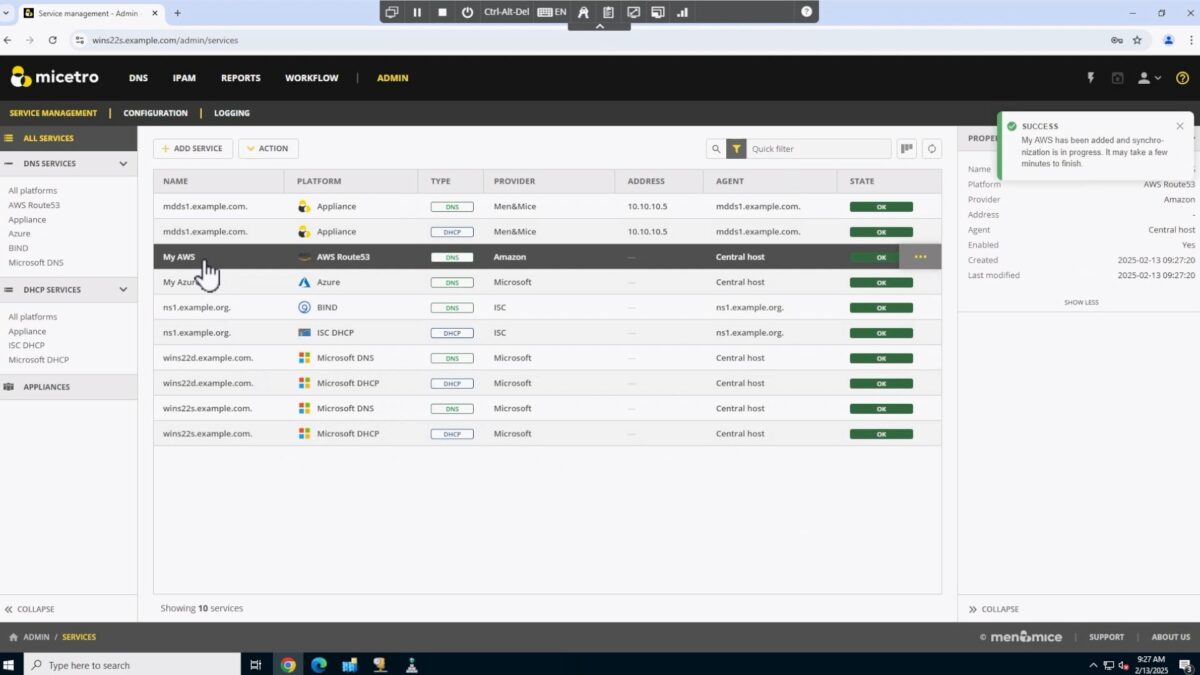
By integrating with Microsoft Azure and AWS, Micetro provides IT teams with:
- Centralized visibility across all environments
- Micetro consolidates DNS records and IP address assignments from on-premises environments, Azure, and AWS into a single management interface.
- IT teams can see all DNS zones, records, and IP allocations in one place, reducing the risk of inconsistencies and misconfigurations.
- Automated DNS and IP address management
- Eliminate manual tracking by leveraging Micetro’s automated workflows for IP address assignments, subnet management, and DNS updates across hybrid cloud environments.
- Automatically discover new DNS zones and IP allocations as cloud instances are created or decommissioned.
- Consistent policy enforcement
- Apply uniform DNS policies across all cloud environments and on-premises infrastructure.
- Prevent unauthorized changes with and audit logging to ensure governance and compliance.
- Improved security and resilience
- Reduce exposure to DNS misconfigurations and cyber threats with real-time monitoring and proactive conflict resolution.
- Ensure high availability and redundancy for DNS services across cloud platforms.
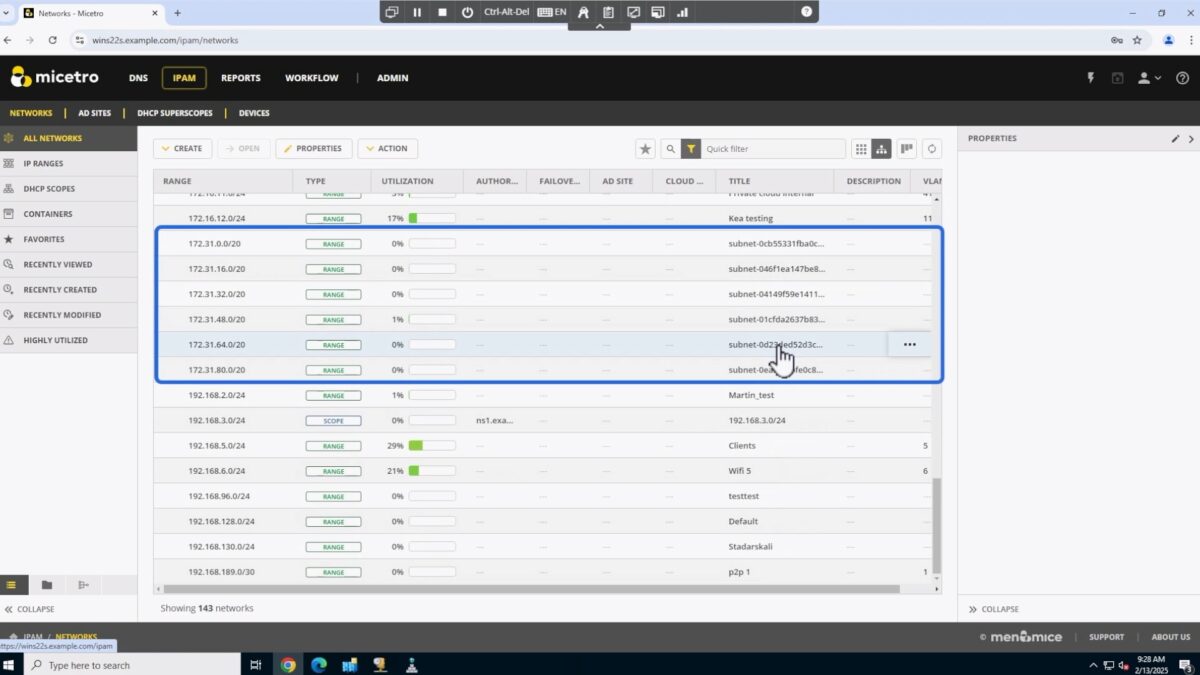
See it in action: Micetro in a hybrid cloud environment
To illustrate how Micetro enables seamless hybrid cloud DNS and IP address management, this demo shows the integration process with Microsoft Azure and AWS cloud environments. Watch as we:
- Connect Azure and AWS to Micetro for unified DNS and IP address management.
- Demonstrate how Micetro simplifies cross-cloud visibility for unified DDI operations.
- Highlight the efficiency gains of managing DNS and IP networks from a single interface to make changes across a hybrid cloud infrastructure.
Future-proof your hybrid cloud network with Micetro
With Micetro, it’s as easy to connect and manage Microsoft DNS and DHCP servers on premises as it is in the cloud. As enterprises expand their footprints into the cloud, a modern and scalable DNS and IP address management approach is even more critical.
Micetro provides IT teams with the tools to maintain centralized visibility, enforce governance, automate, and increase operational efficiency across multicloud environments.
If your organization is looking for a better way to manage DNS and IP address management across on-premises and cloud environments, Micetro is the answer. To learn more about how it can transform your approach to access control, contact us today for a free trial.
BlueCat Solutions Architects cover the potential created by unifying your DDI (DNS, DHCP and IPAM), including real-world solutions and success stories.

